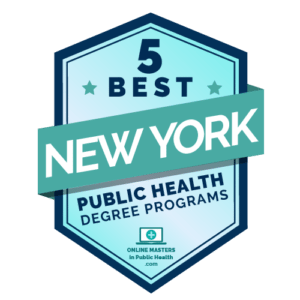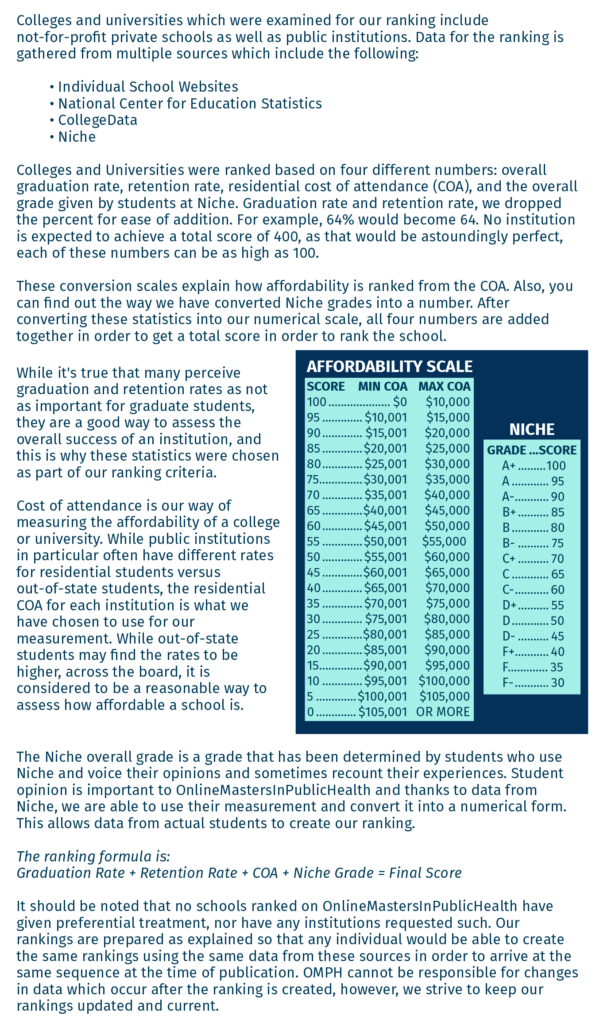 New York is the fourth most populous state in America, behind California, Texas, and Florida. It’s crown jewel, New York City has made it a hub of education, wealth, diversity and public health needs. If New York were a nation, its economy would rank as the 12th or 13th largest in the world. It has a thriving startup culture and is a magnet for top businesses, organizations, government programs and just about anything you can think of. It’s also one of the most economically segregated places in the world. All of this commotion and wealth inequality has led to some extremely pressing public health issues. New York is also an extremely desirable target for a biochemical attack and has looming ecological crises. All of this spells a need for public health professionals that is uncommon, in a city where successful professionals in highly demanded fields like public health are given above average compensation in comparison with the rest of the country. Some of the top MPH programs in New York can be accessed online. Make sure to double-check on any program you’re interested in to guarantee that it’s delivered in a format that fits your needs, whether that be exclusively online, on-campus or in a hybrid delivery format. On this list we’ve ranked five of the best public health degree programs in New York, based on the following methodology:
New York is the fourth most populous state in America, behind California, Texas, and Florida. It’s crown jewel, New York City has made it a hub of education, wealth, diversity and public health needs. If New York were a nation, its economy would rank as the 12th or 13th largest in the world. It has a thriving startup culture and is a magnet for top businesses, organizations, government programs and just about anything you can think of. It’s also one of the most economically segregated places in the world. All of this commotion and wealth inequality has led to some extremely pressing public health issues. New York is also an extremely desirable target for a biochemical attack and has looming ecological crises. All of this spells a need for public health professionals that is uncommon, in a city where successful professionals in highly demanded fields like public health are given above average compensation in comparison with the rest of the country. Some of the top MPH programs in New York can be accessed online. Make sure to double-check on any program you’re interested in to guarantee that it’s delivered in a format that fits your needs, whether that be exclusively online, on-campus or in a hybrid delivery format. On this list we’ve ranked five of the best public health degree programs in New York, based on the following methodology:
Methodology
In building the ranking for The 5 Best Public Health Degree Programs in New York, we here at OnlineMastersinPublicHealth looked through all of the bachelors, masters, and doctoral public health programs available in the state of New York. Programs may be available online, hybrid, or on-campus. These were then examined and evaluated considering the schools which offered them. We then followed a standard methodology which is explained below.

1) Columbia University
Columbia University in the City of New York is a private, Ivy League research university in northern Manhattan. It was founded in 1754. It is the oldest college in NY state and the fifth institution of higher learning in America. Columbia is known for its selectivity and has accepted less than 6% of applicants. Over 29,300 students attend Columbia, which has a 6:1 student-to-faculty ratio. It’s especially known for its graduate schools and offers a wealth of Master’s and Doctoral degrees. USNR ranked it 5th among “national universities” and 8th in its best global universities ranking for 2017. USNR also ranked Columbia’s Fu Foundation School of Engineering and Applied Science (which offers its Ph.D. in Computer Science) 13th in the nation. The Columbia Lions has 29 varsity teams and competes in NCAA Division I FCS. Notable alumni include Barack Obama, Franklin D. Roosevelt, Theodore Roosevelt, and Supreme Court Justices Neil Gorsuch and Ruth Bader Ginsburg, among many others.
Columbia offers a two-year MPH program, in addition to a one-year accelerated MPH for select candidates. Approximately 100 students attend the program, which begins with core courses that aim to answer questions like, “What factors underlie the patterns of disease and premature death in the United States and around the world? What role do environmental factors play? What accounts for health disparities within nations and around the world? And what values come into play in designing interventions to prevent illness and systems to promote health?” Those courses include Foundations of Public Health, Research Methods and Applications, Determinants of Health, Public Health Interventions, Health Systems, and Global and Developmental Perspectives. Students will then choose a discipline from Biostatistics, Environmental Health Sciences, Epidemiology, Health Policy & Management, Population & Family Health, and Sociomedical Sciences to craft their education to their career goals.
If you’d like to learn more, you can check out the Columbia University website.
2) University at Buffalo (SUNY)
University at Buffalo is a public research university based in Buffalo and Amherst. It was founded in 1846. Over 30,100 students attend UB, which has an improbably low 13:1 student-to-faculty ratio. In 2017-18, graduate tuition and fees for UB was $13,384 for in-state students, and $24,724 for out-of-state students. UB offers students access to more than 100 bachelor’s, 205 master’s, 84 doctoral, and 10 professional areas of study. It has consistently been ranked as one of the best schools in the state and country by Kiplinger, USNR, the Wall Street Journal, and more, and is noted for its value. Notable alumni include former president Millard Fillmore, TV talking head Wolf Blitzer, astronaut Ellen S. Baker and many others. The Buffalo Bulls offer 11 men’s and women’s sports and compete in the NCAA Division I.
University at Buffalo’s Master of Public Health degree program covers topics from ecological (air, water), to disease, and much in between. Graduates of this program will be able to confront public health issues for nonprofits, a range of government agencies, private industries, academia and much more. This program comes in six concentrations including Biostatistics, Community Health and Health Behavior, Environmental Health, Epidemiology, Health Services Administration, and an Individualized MPH. UB also offers combined degrees in which students can pair the MPH with a BS, DPT, JD, MBA, MSW, MD or PharmD in another discipline. There is also an accelerated MPH option through UB.
If you’d like to learn more, you can check out the University at Buffalo website.
3) Stony Brook University (SUNY)
Stony Brook University is a public research university based in New York. It was founded in 1957. It has several other campuses, including in South Korea and Manhattan. Over 25,700 students attend Stony Brook, which has a 17:1 student-to-faculty ratio. Graduate tuition and fees at Stony Brook in 2017-18 was $12,635 for in-state students and $23,975 for out-of-staters. It conveys Bachelor’s through doctoral degrees through 12 schools and colleges. Stony Brook’s intercollegiate athletic teams are called the Seawolves. They compete in Division I of the NCAA and are members of the America East Conference and the Colonial Athletic Association. Stony Brook’s alumni have won Nobel Prizes, Pulitzers, Grammy’s and much more.
Stony Brook’s Master of Public Health degree program is also CEPH certified. Its program is aimed at giving students the analytical and critical thinking skills, along with an ecological understanding of health and disease prevention. Students will leave the program as public health problem solvers that can sink their teeth into the health of overarching populations. Sample courses include Biostatistics, Evaluating Public Health Initiatives, Demography and Public Health, Social & Behavioral Determinants of Health, and much more. Students will also be able to choose concentrations in Community Health, Health Analytics or Health Policy and Management, depending on their career goals. The program culminates in a Capstone Seminar and Practicum. It requires 54 credits to complete.
If you’d like to learn more, you can check out the Stony Brook University website.
4)University at Albany (SUNY)
University at Albany is a public research university based in Albany but with campuses in Guilderland, and Rensselaer, New York as well. It was founded in 1844. It offers 50 undergraduate majors and 125 graduate degree programs through nine schools and colleges. Its degree offerings tackle a host of prominent, evolving issues like public policy, homeland security, globalization, documentary studies, biotechnology, bio-instrumentation, informatics, and much more. Albany serves over 17,000 students, with an 18:1 student-to-faculty ratio. In 2017-18, its tuition and fees for in-state students were $12,732, and $24,072 for out-of-state students. Albany’s athletic teams are called the Great Danes and compete in 8 men’s and 10 women’s sports in the NCAA Division 1. Notable alumni include 2017 Nobel Prize winner in Chemistry Joachim Frank, 2018 Wolf Prize co-recipient Omar Yaghi, a University of California, Berkeley chemist, and politician and gay rights activist Harvey Milk. Its public health program was ranked 25th in the country by USNR in 2014.
University at Albany’s Master of Public Health degree program allows students to take a concentration in biomedical sciences, biostatistics, environmental health, epidemiology, health policy and management, social behavior and community health, or public health practice. This program requires 720 internship hours, which is more than any other MPH program in the country, according to Albany. This demonstrates a real commitment to practical education that can’t be substituted by purely academic engagement. Core courses in this program include Principles and Methods of Epidemiology, Principles of Statistical Inference, Health Care Organization, Financing and Delivery, Social and Behavioral Aspects of Public Health, and many others.
If you’d like to learn more, you can check out the UAlbany website.
5) University of Rochester
The University of Rochester is a private, research university headquartered in Rochester. It was founded in 1850. Over 11,200 students attend Rochester, which has a 10:1 student-to-faculty ratio. Rochester conveys degrees at all levels through schools of Arts, Sciences, and Engineering, Music, Education and Human Development, Medicine and Dentistry, Nursing, and Business. In 2017-18, Rochester graduate tuition and fees were $38,643. UR’s athletic teams are called the Yellowjackets. They compete mostly in Division III of the NCAA, although the men’s squash team competes in Division 1. Overall, Rochester offers 11 varsity men’s sports and 12 women’s. Rochester’s collection of notable alumni are extremely diverse and accomplished. They include Arthur Kornberg, Steven Chu, and four other Nobel Laureate winners, among many others.
Rochester’s Master of Public Health degree program began in 1970, and has been responsible for groundbreaking research in public health concerns like “tobacco control, air quality, breastfeeding, maternal/child health and nutrition, HIV prevention and deaf health.” This program requires 43 credits and was created to accommodate students who are working full time. It grapples with ongoing and developing problems in public health, especially public health education and the need to serve economically and racially oppressed people. It has been accredited by the Council on Education for Public Health (CEPH) and is also known for its quality faculty. It also offers several related Master’s degrees for students who have somewhat overlapping but distinct career goals.
If you’d like to learn more, you can check out the University of Rochester website.